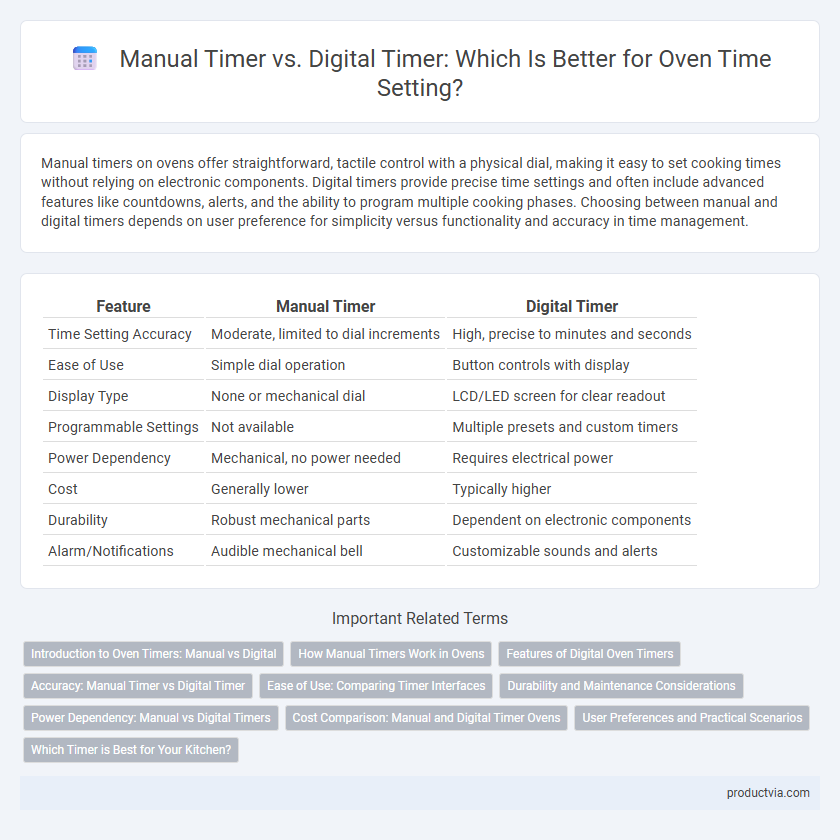Manual timers on ovens offer straightforward, tactile control with a physical dial, making it easy to set cooking times without relying on electronic components. Digital timers provide precise time settings and often include advanced features like countdowns, alerts, and the ability to program multiple cooking phases. Choosing between manual and digital timers depends on user preference for simplicity versus functionality and accuracy in time management.
Table of Comparison
| Feature | Manual Timer | Digital Timer |
|---|---|---|
| Time Setting Accuracy | Moderate, limited to dial increments | High, precise to minutes and seconds |
| Ease of Use | Simple dial operation | Button controls with display |
| Display Type | None or mechanical dial | LCD/LED screen for clear readout |
| Programmable Settings | Not available | Multiple presets and custom timers |
| Power Dependency | Mechanical, no power needed | Requires electrical power |
| Cost | Generally lower | Typically higher |
| Durability | Robust mechanical parts | Dependent on electronic components |
| Alarm/Notifications | Audible mechanical bell | Customizable sounds and alerts |
Introduction to Oven Timers: Manual vs Digital
Oven timers play a crucial role in cooking precision, with manual timers typically offering a straightforward dial mechanism for setting cooking duration, favored for their simplicity and reliability without power dependency. Digital timers provide advanced features such as precise countdowns, multiple cooking stages, and integration with smart home systems, appealing to tech-savvy users seeking convenience and enhanced control. The choice between manual and digital oven timers depends on user preference for ease of use versus feature-rich functionality.
How Manual Timers Work in Ovens
Manual timers in ovens operate through a mechanical dial that users turn to set the desired cooking duration, activating an internal spring mechanism that counts down the time. As the spring unwinds, it triggers a bell or switches off the oven once the set time expires, ensuring precise control without reliance on electronics. This simple, durable system provides reliable timing for baking and roasting, especially valued in traditional kitchen appliances.
Features of Digital Oven Timers
Digital oven timers offer precise time setting with easy-to-read LED or LCD displays, allowing users to program cooking durations down to the minute. Features such as multiple timer presets, countdown alerts, and the ability to pause or adjust cooking times enhance user convenience and accuracy. Integration with smart home systems and voice control further elevates the functionality of digital oven timers compared to traditional manual options.
Accuracy: Manual Timer vs Digital Timer
Digital timers offer higher accuracy for oven time settings, allowing precise control down to the minute or second for consistent cooking results. Manual timers rely on mechanical components that may introduce slight variations and less precision, potentially leading to unevenly cooked food. For complex recipes requiring exact timing, digital timers provide a more reliable and user-friendly experience than manual dials.
Ease of Use: Comparing Timer Interfaces
Manual timers offer a tactile, straightforward interface with a physical dial, allowing users to easily set cooking times without navigating complex menus. Digital timers provide precise time adjustments and often include clear displays with countdown features, enhancing accuracy and visibility. The choice between manual and digital timers depends on user preference for simplicity versus precision in time setting.
Durability and Maintenance Considerations
Manual timers in ovens feature simple mechanical parts that enhance durability and require minimal maintenance, often lasting several years without issues. Digital timers offer precise time settings and additional functions but may be prone to electronic failures and generally need more careful handling and occasional software updates. Choosing between the two depends on balancing long-term reliability of manual mechanisms against the advanced features and potential maintenance needs of digital systems.
Power Dependency: Manual vs Digital Timers
Manual oven timers operate mechanically and do not rely on power, ensuring time settings remain accurate even during power outages. Digital timers require continuous electricity to function, and any power failure can reset or disrupt the timing process. Choosing between manual and digital timers depends on the need for power independence versus features like precise digital control and programmability.
Cost Comparison: Manual and Digital Timer Ovens
Manual timer ovens generally offer a lower upfront cost, making them an affordable option for budget-conscious consumers, while digital timer ovens typically come with a higher price due to advanced features and precision. Maintenance expenses tend to be lower for manual timers, as they have simpler mechanical parts compared to the electronic components of digital timers that may require specialized repairs. Over time, digital timers can provide more efficient cooking control, potentially saving on energy costs despite the initial investment, whereas manual timers rely on basic, less accurate timing that may lead to longer cooking durations.
User Preferences and Practical Scenarios
Manual timers offer tactile control and simplicity, favored by users who prefer straightforward, intuitive settings without relying on electricity or complex programming. Digital timers provide precise time adjustments and additional features like countdown displays and programmable presets, ideal for users needing exact cooking times or multitasking in busy kitchens. Practical scenarios such as frequent use and energy-saving preferences often influence the choice between the reliable mechanical design of manual timers and the advanced functionality of digital options.
Which Timer is Best for Your Kitchen?
Manual timers offer simplicity and tactile control, making them ideal for users who prefer straightforward, mechanical settings without reliance on batteries or electronics. Digital timers provide precise time adjustments, multiple cooking modes, and easy-to-read displays, enhancing convenience in busy kitchens. Choosing the best timer depends on your need for accuracy, ease of use, and whether you value traditional reliability or advanced features in oven time setting.
Manual timer vs Digital timer for time setting Infographic

 productvia.com
productvia.com